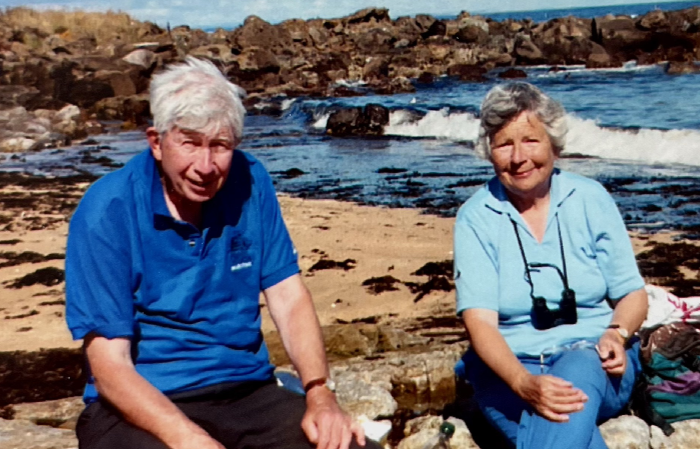Born on this day in 1930, Dr Dinwoodie, who died last year, was a member of the Royal Scottish Pipers’ Society and a lifelong supporter of the Piobaireachd Society. This touching tribute was written by his son Colin…..

There is never a good time to begin writing of a parents’ passing, and until now I have felt unable to keep pace with life and prepare this for my father, a man for whom there were never enough hours in the day, never too many people to help, and most certainly never a moment of his life to waste.
Hugh passed away aged 92 on the 21st of August 2023 having suffered a bad fall whilst holidaying in Cumbria. I am grateful to those who showed their love and care for him in his ageing years and throughout his long and well-lived life.
Hugh Parker Dinwoodie was a general practitioner, an enthusiastic piper, a lifelong climber and a keen archaeologist. Born in Derby in 1930, he was the son of a doctor practising in England. One of three siblings, Hugh, the eldest, Alison (1932) and Andrew (1934 – 2011).
When he reached school age Hugh was sent back to Scotland to be educated at Merchiston Castle School where his introduction to piping first took hold. He later became Pipe Major. The pipes remained a passion all his life.
It was no surprise that after Merchiston he should then progress to Glasgow University to study medicine. Here he was to discover two new loves – climbing through the GUM club [Glasgow University Mountaineering Club], and that of another trainee doctor and climber, Doreen Ireland (1930 – 2022).
Hugh graduated from Glasgow University, and as soon as he had completed his hospital training, he married Doreen and set about finding a practice. After a brief time in Perth, he accepted an offer to go into partnership with Jacko Simpson in Trinity, Edinburgh, where he would practise and live for the next 66 years with Doreen by his side.
After acting as his partnership secretary for several years, she went back to work as a family planning counsellor when child-care allowed, then at the thyroid review clinic at the Western General Hospital, before becoming a genetic counsellor working well past her retirement years.
During his lengthy career Hugh was known for seeking out new innovations and ways to improve patients’ lives, and so it was no surprise to learn he was one of the first to embrace computerisation.
Unlike many doctor’s handwriting, his was both cursive but, more importantly, legible. Despite this, he recognised the benefit of having digitised patient files, offering quick access to patient data, even though it took him many, many hours of painstaking work to create the early records.
There was something timeless, almost old fashioned about his ability to tune into patients who would say ‘it is probably nothing, doctor, but’. No advances in technology can replace that ability to home in on the most important revelations.
Away from medicine he would spend hours researching topics close to his heart, particularly on behalf of the Edinburgh Archaeological Field Society. He was especially pleased to ‘rediscover’ the Corrour Old Lodge south of Loch Ossian – not to be confused with the Old Corrour Lodge!
Despite his ageing years his enthusiasm and lively curiosity never waned. During his 80s and 90s he was still living a very full life including regularly climbing Arthur’s Seat in Edinburgh (once with much indignation for the congratulations offered from a much younger climber).
When the country came out to applaud the NHS during lockdown, Hugh, then aged 90, stood proudly on his balcony dressed in his kilt and played the pipes for 30 minutes each evening. That is a measure of the inimitable spirit he exhibited – a true gentleman with a lively spark in his eye and a story to be retold.
Hugh died in Newcastle upon Tyne. Had he had any say in the matter he would have been in his beloved Wester Ross high on the mountain side of An Teallach.
Colin Dinwoodie
















